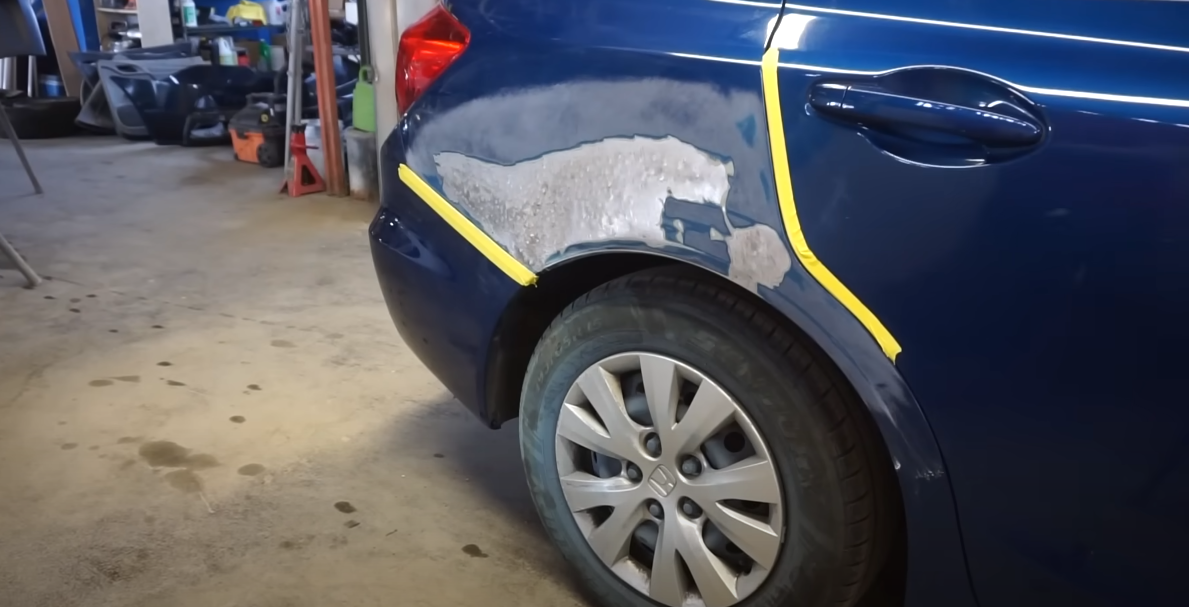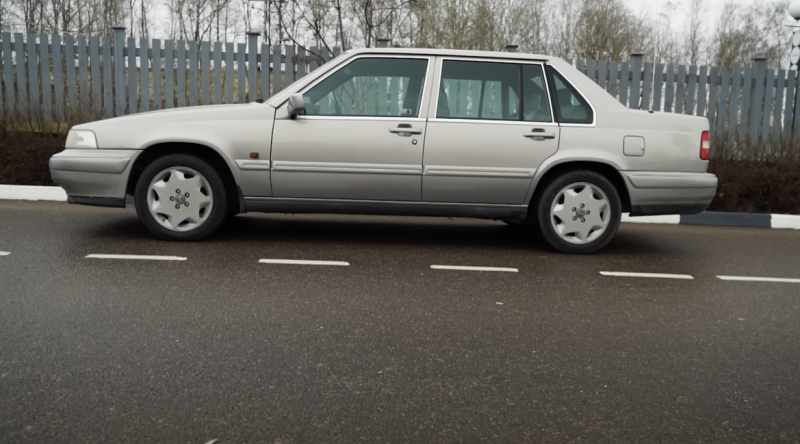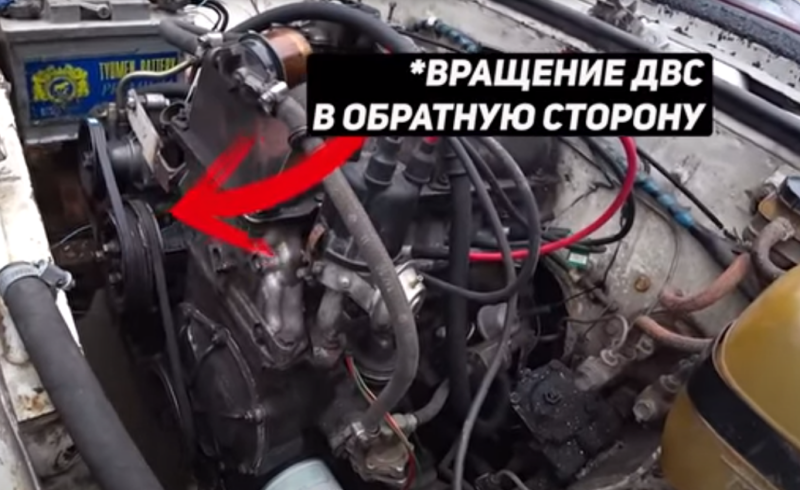But painting a car with your own hands is not so difficult. This requires equipment, tools and materials, and most importantly - skill.
As practice shows, the first experience in self-painting is often unsuccessful. Often, spoiling one element, the owner of the car dooms himself to a complete dousing. Professionals recommend specially practicing on some old car. If not, a door, fender, or hood/trunk lid will do.
 Even when painting with a spray can, you need to train, not to mention the compressor. Photo: Youtube.com
Even when painting with a spray can, you need to train, not to mention the compressor. Photo: Youtube.comBut even a perfectly done job can go down the drain due to the wrong choice of equipment and materials. Of course, this is not relevant for professionals, but it is advisable for beginners to pick up everything that is required by technology.
Today we start a series of three articles on car painting. The first will talk about the selection of the necessary equipment and materials. It should be noted that for painting one or two elements, buying everything is unreasonably expensive.
And if you need to douse the whole car, then you can not only win financially, but also put the work on stream. This is true for resellers and those who often change cars. If you take models with paintwork problems, they will cost less.
Compressor and "mounted"
The first thing you need to paint a car is a compressor. Without it, it is not worth starting work. Of course, some people manage to paint a car entirely from spray cans, but this is a scheme for frank dealers.
 A great option for a beginner is a two-cylinder compressor. Photo: Youtube.com
A great option for a beginner is a two-cylinder compressor. Photo: Youtube.comSo the compressor. This is such a contraption that makes the spray gun work, it is also a “gun” for spraying. It is recommended to purchase models with an air tank of at least 50 liters. Such a compressor does not have to constantly rumble.
It is advisable to buy two-cylinder models - they are not much more expensive. But a “single-barrel” is also suitable if you want to save as much as possible.
When purchasing a compressor, you need to pay attention to:
✅ The volume of the oil tank - preferably more
✅ At least two outlets for hoses
✅ Copper tubes - cool better
✅ Presence of a faucet for draining condensate
There is another nuance that is often overlooked. The compressor carrying handle on the back must be welded in at least two places. As practice shows, otherwise it can be broken off, even with a piece of the compressed air tank.
 Here the handle is welded in two places. Photo: Youtube.com
Here the handle is welded in two places. Photo: Youtube.comThe compressor will need a hose. It is recommended to choose reinforced, not spiral. The latter, although light, do not differ in particular strength. Of course, if you take a branded spiral hose, then it will not cause problems, but its cost is too high.
Fittings for connecting to the compressor should also be of high quality. As a rule, they are included in the kit, but in some cases it is cheaper to change these parts yourself. The main problem with poor quality fittings is jamming.
Filter for separating oil and condensate. Many people neglect this consumable, but a "spit" can ruin all the work on the whole element of the car. Filters are different - from cheap to expensive with a pressure gauge and regulator.
Well, the "pistol", aka the spray gun. Despite the assurances of professionals that only branded products work, you can take almost any, avoiding only very cheap "no name" models.
The universal nozzle diameter for painting is 1,4 mm. After using the spray gun, it must be washed. Not water, of course, but a solvent.
 Two spray guns can be connected at the same time. Photo: Youtube.com
Two spray guns can be connected at the same time. Photo: Youtube.comBefore starting work, you need to practice on some surface, preferably a body part. In the process, you should adjust the width of the "torch" and the amount of paint supply.
Putty tools
The first thing you need is a grinder. It is needed to remove rust or damaged paintwork. This tool is also useful for preparing the body, cleaning welds.
Which grinder to choose is a personal matter for everyone. Of course, it is better to take the one that is easier and of a proven brand. “Chinese” have been serving someone for years, and if you want guaranteed quality, then Bosch or Makita is better.
A grinder is also recommended - it can save your nerves and reduce the hours of monotonous manual work by several times. It is better to choose an orbital model, preferably pneumatic. If there are no extra funds, any will do.
 A grinder also needs to learn how to work. Photo: Youtube.com
A grinder also needs to learn how to work. Photo: Youtube.comEvery painter who respects his work should have a sander. This is a special device for convenient work with sandpaper. They are different, it is better to buy several.
Sandpaper - you need a lot of it. To work with putty, the grain size is selected from 80 (the coarsest) to 320.
For further work you will need:
✅ 500-800 for soil
✅ 1 for smudges
✅ 1 500 - removal of shagreen
✅ 2 - preparation before polishing
It is advisable to use materials from leading manufacturers. In general, sandpaper grit can reach 10, but this is already for fans and aesthetes.
Flexible abrasive materials, such as special sponges and Scotch brights, will not interfere either. Although, some in the most inaccessible places wield pieces of sandpaper and a few fingers.
 The more numbers of sandpaper, the better. Photo: Youtube.com
The more numbers of sandpaper, the better. Photo: Youtube.comA construction knife like a clerical knife is always useful. Like cutting something. Some manage to remove excess putty in this way.
Spatulas for applying the material - only not plastic. Professionals recommend metal ones, rubber ones can be advised for beginners.
Necessary materials for work
To get the perfect painting, you need to worry about consumables in advance. The first thing you need is masking tape and special masking paper or film. Covering glass and other elements with newspapers is a so-so method.
 Film wrapping. Photo: Youtube.com
Film wrapping. Photo: Youtube.comTo treat places where there was rust, you will need a converter and acid soil. You can use one, but it's better to use both.
You will also need primers:
✅ Epoxy - it forms a moisture-impervious layer
✅ Filler for putty
✅ Finish
✅ For plastic
You can do without something, but if you do it for yourself or on your conscience, it is better to immediately purchase all of the above. Some soils can be purchased in spray cans - it's easier to work pointwise.
You need paint, it can be basic, if it is metallics and mother-of-pearl or acrylic. For the latter, varnishes are not needed, but only old and budget cars are covered with such. An average passenger car will need about three liters, although a lot depends on how you work. Some take a lot more paint.
To avoid lumps in the material, special filter funnels are needed.
Thinner is required for base and varnish. You should not buy cheap solvents, such as P-12 or 646 - you can spoil the result and expensive paint. It is recommended to purchase high-quality materials, preferably from the same manufacturer as the base / varnish.
 The tool must be kept clean. Photo: Youtube.com
The tool must be kept clean. Photo: Youtube.comTo clean the spray gun, you need a solvent. This is where the cheap one comes in. It will take a minimum of 5 liters. If you save on this, then for the next painting, you may have to change the spray gun.
If you have to work with mother-of-pearl or metallics, you will need varnish. It is needed, like paint, an average of 3 liters.
To dilute materials in the required proportions, you will need measuring cups. It's better to buy more.
Also useful:
✅ Wipes for degreasing and sticky
✅ Sticks for mixing materials
✅ Protective equipment, which includes a mandatory respirator
It is advisable to separately buy a liter or two of anti-silicone.
Putties need several types. There are special formulations for working with plastic. For large irregularities, putty with glass or carbon fiber is suitable. There is material with aluminum powder. It is used in places where strong heating is possible - it cracks less often.
More often used universal putty, it is also filling. Professionals are also working at the finish line.
 Putty also needs to be selected according to the situation. Photo: Youtube.com
Putty also needs to be selected according to the situation. Photo: Youtube.comHardeners for putties are the same, so you don’t have to throw them away, but they come with each can.
After painting is completed, you will need polishing pastes and a machine. You should work with this power tool carefully, having previously trained on an unnecessary body part. Otherwise, you can spoil the result, after which you have to redo it.
Now the materials are purchased - you can get to work. In the next article we will talk about preparing the car body for painting.










